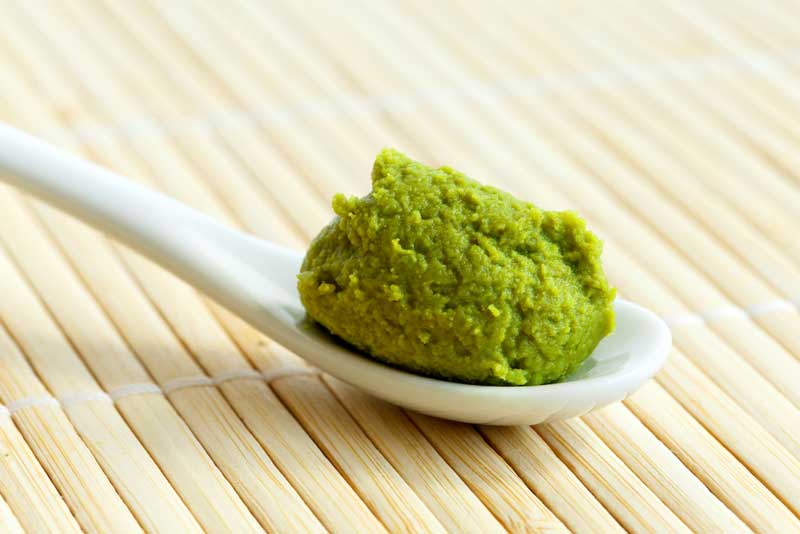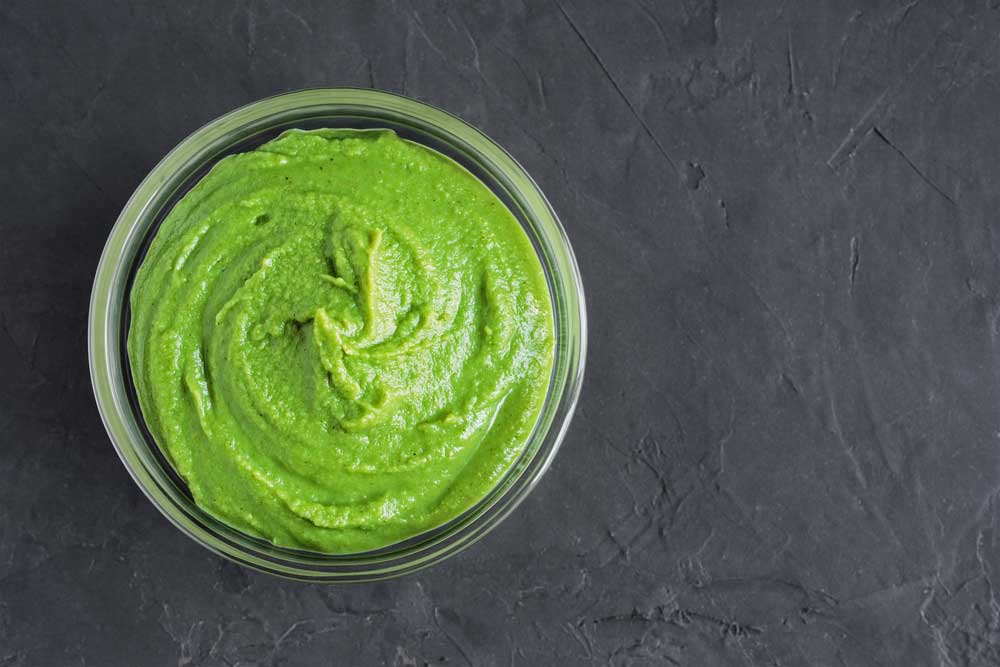Are you wondering, “How hot is Wasabi? This article is for you.
You visit this upscale Japanese restaurant and request a sushi dish. After a short time of making your order, you receive the sushi dish as tasty-looking as possible. Along with the sushi is a green paste that looks green and gritty. That’s wasabi!
While this might be a new experience for some, others are familiar. The green seasoning that goes perfectly well with your sushi plate and lights you up with its heat is what the Japanese call wasabi.
A little finding will help you realize that wasabi is not the regular chili pepper. If that is the case, what makes it hot? How hot is wasabi?
Wasabi is said to be as hot as Jalapeño Peppers, with a heat level that is between 2,500 SHU and 8,000 SHU.
This article will take you on a tour of everything you need to know about wasabi and, most especially, answer the controversial question about wasabi; how hot is wasabi?
What is Wasabi?
If you have had sushi in the past or recently, it is likely that wasabi is familiar to you. Wasabi is an excellent seasoning as you do not have to worry about the taste you will have in your mouth after each bite. However, wasabi is not only used with sushi as it can spice up other meals. Horseradish, mustard, and wasabi are members of the family of plants called Brassicaceae. The wasabi paste comes from stems called rhizomes.
Wasabi is said to have been around since 800 AD. The excavations that led to its discovery suggest that medicinal use was its original purpose. The fermentation of sushi brought a new light to the food industry, and with time, wasabi found its way to the favorite condiment. The use of wasabi as a favorite condiment can be attributed to its ability to prevent food poisoning and taste.
What Makes up Wasabi?
The wasabi paste was made by shredding the natural wasabi, which was eaten as a seasoning and a dish to create excellence. In the past, the graters used to shred wasabi include oroshigane and sharkskin and, to this day, are recommended as an excellent wasabi grater. Vinegar and soy sauce were usually added to the wasabi individually or together. This improved the look and taste of the paste and is, in fact, the way some of the traditional wasabi is made in Japanese and Japanese restaurants.
It is sad to note that in recent times, the use of wasabi in making wasabi paste is no longer a common practice, and this is due to wasabi currently being delicate and expensive. Yes, the wasabi served at most outlets is not made with real wasabi but rather a mixture of ingredients to replace it in its taste, spiciness, and color. The ingredients are usually mustard, regular horseradish, and food coloring (green). The elements and amounts of it depend on the recipe used by the company making it.
Also Read: How Long Is Ceviche Good For? (Explained)
What Makes Wasabi Hot?
The wasabi plant contains a certain chemical that can get our bodies to react interestingly. People eating wasabi might end up shedding tears due to the chemical in wasabi that gives it a hot and strong taste. What is this chemical? The organic compound is called allyl isothiocyanate, a chemical common to the Cruciferae plant family members such as mustard.
Some cells in the human body have receptors that react with this organic compound and cause them to feel the heat the wasabi gives off. Chilies have a similar action on us, causing a burning feeling that can lead to tears as the body tries to respond to the unfamiliar foreign chemical.
The stingy feeling experienced with consuming wasabi can be enjoyable and have adverse effects if taken in excess. Yes, the sting can become unendurable when it gets to the head. For this reason, it is recommended that wasabi be eaten in reasonable amounts in any instance. However, some people can take in a lot of wasabi and still manage the heat without problems. If that is the case with you, enjoy yourself!
How Hot is Wasabi?
Unlike the heat from regular peppers, the spiciness from wasabi results from the action of a compound that is not the same as that in regular peppers. What is more? The heat from wasabi only hangs around for a little bit longer than that from regular peppers. There is more good news; the spicy flavor in the wasabi is balanced by umami, which is usually more in real wasabi.
Some people have tried raw peppers or are regular in hot food and have no issues after trying them. If you fall into this category, you will likely avoid problems with wasabi, even when consumed in large quantities.
Can the Hotness of Wasabi Be Compared to That of Chili Peppers?
Because of the different chemical compounds in wasabi and chilies, comparing the heat from wasabi and chilies is difficult as there are no generally acceptable scales for measuring the spiciness.
However, we can draw some information on the topic from comparing the way the heat from wasabi and chili peppers feels like
The heat from chili peppers results from capsaicin, which causes a burning sensation in the mouth, lips, and tongue. The heat from hot peppers only goes away slowly, as it has been found to last for as long as 30 minutes or more.
In contrast to hot peppers, wasabi does not attack the mouth but rather the nose. Once the wasabi is in, you feel the sensation in your nose and throat when you try to breathe out. In addition to what it does to the nasal cavity, very spicy wasabi may temporarily affect your hearing and eyes, causing tears to roll down your cheeks.
However, the effects of hot wasabi are only short-lived. The heat results are far shorter than hot peppers as it only lasts for less than a minute.
The extent to which each person feels the heat from hot wasabi depends on the individual, and the only way to know your endurance limit is to try more.
Also Read: Is Salt a Spice? (Explained)
Am I Eating the Real Wasabi?
Realizing that there is a fake and real wasabi, you may be wondering if it is possible to distinguish the fake from the real. The first thing to do is to check the smoothness of the paste. If the paste is smooth and thick, it will most likely be horseradish and not real wasabi. However, if the paste has some particles, as in grittiness, it indicates that it is not fake but real wasabi.
When the wasabi plant is grated, and the real wasabi paste is made, the flavor and heat do not last for long, and that is why real wasabi can only be served fresh. When you visit a sushi or Japanese restaurant serving real wasabi, the experienced chef will only grate the right quantity for the sushi dish.

The Health Benefits of Hot Wasabi
Wasabi affects our health in several positive ways. If you have had wasabi, you might have realized that wasabi removes sinuses almost immediately. Some people say it is only an illusion, as it does not, in the real sense, eliminate the sinuses but rather tricks your brain into believing that the nose is clear. Whichever way, you will feel better.
The wasabi plant has several healthy vitamins like vitamins A, B, and C. In addition, are minerals like magnesium, calcium, and potassium. It is a no-brainer that these minerals and vitamins should make up a good part of our daily meals as they are known to keep our bodies running properly and efficiently. The fact that it is a plant and contains fibers essential to the body cannot be overlooked.
As aforementioned, the wasabi plant was originally used for medicinal purposes. Some of its medical uses include curbing diarrhea, improving the functionality of the large intestines and digestive system, and building the body’s ability to fight illnesses. Another very important benefit is that it can be used to prevent food poisoning.
Research has it that wasabi can lower the potential of having some forms of cancer. Thus, regularly eating wasabi increases your chances of benefiting from its anticancer features. Also, wasabi’s sodium and cholesterol content is little and nothing to worry about. So asides from the effects of the heat from the plate, you have little or nothing to worry about.
Since most restaurants do not serve real wasabi, how can I benefit from the health benefits of wasabi? Notably, the wasabi made from horseradish also has some advantages as they are both from the Cruciferae plant family.
Frequently Asked Questions-How Hot Is Wasabi?
Is Wasabi Considered Spicy or Hot?
Wasabi is both hot and spicy. However, unlike the heat from hot peppers, wasabi hits the nose rather than the mouth, lips, and tongue.
Is Wasabi Hot or Sweet?
Brassicaceae is a plant family of which cabbage, broccoli, and wasabi are members. It is spicy, not completely smooth, and gives you a sparingly sweet sensation and heat after every bite.
What Happens if You Eat Wasabi?
Some people might get an allergic feeling after consuming wasabi which is particular to them. However, apart from the sinuses removal and the heat you feel in your nose and eyes after consuming wasabi, there is nothing to worry about when you eat wasabi.
Can You Eat Raw Wasabi?
It is a common practice to fry or roast peas, soybeans, or peanuts and then rub them all over with wasabi that has been grounded and mixed with oil, salt, or sugar to make a crispy snack. However, eating the fresh leaves of the wasabi plant might cause diarrhea.
Can Wasabi Damage Your Stomach?
Spicy meals are known to increase acid levels in the body, and wasabi is one spicy season we know. Consuming lots of wasabi can cause a large deposit of the toxin it contains, thus, providing more work for your liver. Still, it is advisable to watch your wasabi intake if you suffer from heartburn, stomach ulcer, and digestion issues.
Also Read: 25 Foods that start with the letter Y (Latest Edition)
Conclusion-How hot is Wasabi?
The Japanese love wasabi, leading to its extensive usage as a condiment for several dishes. There is little doubt that you will also enjoy it when you try it with your sushi.
It is famous for its spicy flavor. Yes, wasabi is hot. However, it is not desirable in the same as chili peppers because the chemical compounds behind the heat they give are different. While the heat from the hot peppers attacks the mouth, the heat from the wasabi attacks the nasal cavity and removes the sinuses.
The heat from wasabi can be extremely hot, depending on your endurance limit; however, if you can handle large amounts of hot peppers, you have nothing to worry about. What is more? The heat from wasabi is short-lived.

